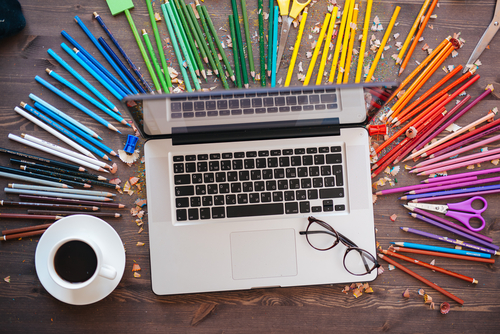5 Tips to Organize Your Graphic Design Workspace
Organization is one of the many essential ingredients for a successful workspace. Proper organization improves efficiency and reduces distractions, enabling you to work productively. As a graphic designer, maintaining a clean workstation can free your mind of outside constraints, allowing you to unleash your creativity and create inspired designs quickly.
Keep Clutter Away
A desk that is populated with old food wrappers and work documents can clutter your mind and block inspiration. Use storage solutions, such as file folders or mail bins, to keep track of and organize your papers. If you have a massive pile of clutter to work though, knock it out a small square at a time. Once your desk is clean, invest a few minutes each day to clean it up. Keep a trash can close by for food leftovers and designs that didn’t pass muster.
Invest in Digital Storage
As a graphic designer, you work with thousands of images and files that can take up considerable space on your computer. Some of these files are irreplaceable and could cost you work from a client if something happens. Investing in plentiful extra storage is a good way to help you keep your computer organized. You can use a number of different options for your storage, including cloud storage and external hard drives. Create your own organization system to use with your files so that you can instantly find a file whenever you need it.
Create an Effective Desk Layout
Piling all of your essential work items, such as reference books, tablets and scratch paper, into one space can make it difficult to stay organized. Think about creating discrete stations within your workspace. For example, one section can be devoted to your sources of inspiration, including art books and previous successful designs. Another section can hold all of your computer peripherals, such as a printer and an external hard drive. Setting up simple zones can help you complete your tasks without being hampered by unrelated items.
Pay Attention to Ergonomics
When you’re designing your workstation layout, make sure that you don’t neglect your physical comfort. If you have to stretch or strain to use something at your station, you’ll tire out more quickly and may put yourself at risk of a repetitive strain injury. The quality of your seating is important too; sitting on an old office chair and peering at your monitor at an uncomfortable angle can cause back pains and eye strain. Investing in a high-quality office chair that allows you to adjust its height is a smart choice. Learning how to sit properly at your desk can also help you avoid injury.
Make Work the Priority
Filling your desk with non-essential items, including personal effects and desk toys, can impact your ability to stay organized. Help your work take center stage on your desk by eliminating these distractions, especially if your workspace is at home. If it’s practical, keep your design computer devoted solely to your work to prevent personal issues from creeping into your professional time. Set clear boundaries for those who live with you to ensure that their belongings don’t overrun your desk. You don’t have to keep your workspace bland and sterile, however. A few plants and favorite photographs won’t impact your work and may even help you to become more productive.
Concluding Thoughts
A cluttered and disorganized workspace can negatively impact productivity. Although it may not seem appealing to regularly clean up your space and remove distractions, these simple tasks can have a big impact on the quality of your work as a graphic designer.
Related Resources:
- Top 10 Online Graphic Design Degree Programs
- 5 Tips to Design Your Graphic Design Website
- 5 Ways to Get Traffic to Your Graphic Design Website
- 30 Great Graphic Design Scholarships for Graphic & Website Design Majors
- Top 13 Best Affordable Graphic Design Degree Programs
- Top 15 Online Associate in Graphic Design
- Top 15 Online Bachelor’s in Graphic Design
- Top 8 Affordable Online Graphic Design Master’s Degrees
